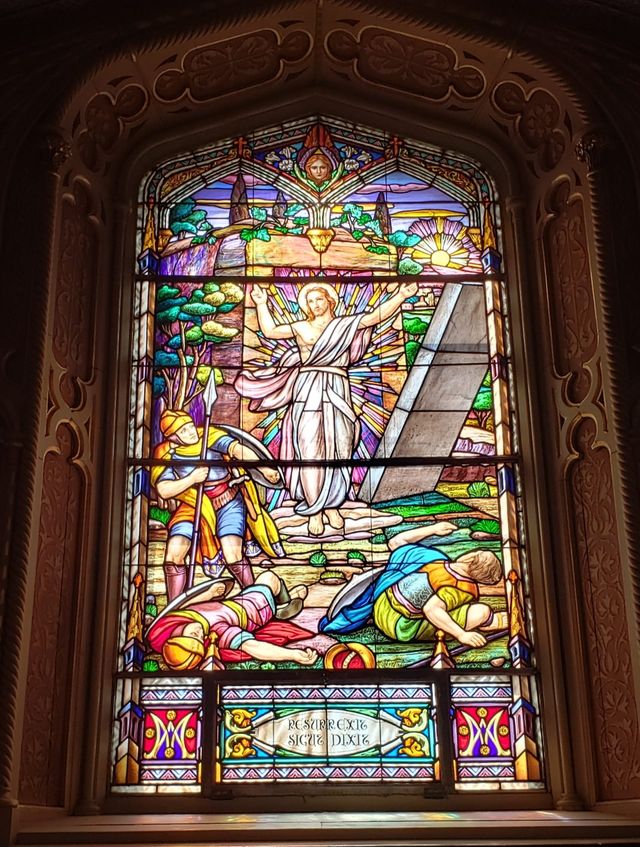
The Resurrection of the Lord
Gospel according to John 20:1-9
On the first day of the week, Mary of Magdala came to the tomb early in the morning, while it was still dark, and saw the stone removed from the tomb. So she ran and went to Simon Peter and to the other disciple whom Jesus loved, and told them, “They have taken the Lord from the tomb, and we don’t know where they put him.” So Peter and the other disciple went out and came to the tomb. They both ran, but the other disciple ran faster than Peter and arrived at the tomb first; he bent down and saw the burial cloths there, but did not go in. When Simon Peter arrived after him, he went into the tomb and saw the burial cloths there, and the cloth that had covered his head, not with the burial cloths but rolled up in a separate place. Then the other disciple also went in, the one who had arrived at the tomb first, and he saw and believed. For they did not yet understand the Scripture that he had to rise from the dead.

Reflections
“Hallelujah! He is risen! He is risen indeed!”
It is striking how precisely and without delay God kept His promise. It was not even daylight yet, the third day after Jesus had been laid to rest, that “…Mary Magdalene came to the tomb and saw that the stone had been removed from the tomb” (John 20:1). According to Jewish tradition, Jesus’ body has been honored by washing, anointing with spices, wrapped in clean white linen cloth, and placed onto a rock shelf in a fresh new rock-cut tomb where no one has been laid before. (1) The entrance to the tomb had been sealed with a heavy carved rock, covering the opening, and making it impossible for anyone to enter without authorization. Guards were placed by the entrance by the authorities, who wanted to make sure that no one could steal the body and claim that “he has risen from the dead.” (Matthew 27:65). The tomb belonged to Joseph of Arimathea, a respected member of the Jewish council who did to agree with the unjust condemnation of Jesus who offered his own family tomb located near the site of his crucifixion on the hills of Golgotha, outside the city of Jerusalem (Mark 15:43). Mary Magdalene, who participated in preparing Jesus’s body for the burial, along with Nicodemus, Joseph of Arimathea, Mary the mother of James, Susanna, Salome, and other women, knew of its location and went there early in the morning, as soon as the observance of the Sabbat was over, to bring some additional oils and spices and anoint Jesus’ body with it (2,3) Upon reaching the tomb, finding the stone rolled away, and the guards missing, her shock was probably immense.
At this point, Mary Magdalene was not sure what exactly happened. She, like the other disciples, recalled Jesus’ words, according to which “…The Son of Man must be delivered over to the hands of sinners, be crucified and on the third day be raised again.” It was the third day. Was it possible; did He rise from the dead!? Mary Magdalene herself saw Jesus’ dead body. She touched it, washed it, wrapped it with care and helped to place it into its resting position. Instantly, she turned and ran with haste to tell the disciples who were still hiding in fear of the authorities.
Simon Peter and John raced to the tomb and ascertained that Mary Magdalene’s words were true. They saw the linen wrappings lying there, “…and the cloth that had been on Jesus’ head, not lying with the linen wrappings but rolled up in place by itself” (John 20:7). The place did not look like it had been ambushed or ransacked, it did not look like someone had violently broken in to snatch the body, the wrappings that covered Jesus’ body were not scattered, but folded and left in place. This was material evidence that his body had been in that tomb, even though they no longer saw it there. They looked around but saw no further signs or indications of wrongdoing. There was only one explanation left, which they kept repeating to themselves in disbelief: Could it be that he rose from the dead?! The realization flooded their minds with confusion. Not even prophets rose from their death in the Old Testament. Moses and Elijah were assumed into heaven (Deuteronomy 34:5-6; 2Kings 2:11-12). Lazarus, whom Jesus raised from the dead, came back with his linen wrappings still tied about him, and had a physical body which continued to age and died in the hope of the resurrection of the body on the Last Day (John 11:1-44).
The Apostles left to inform the others, but Mary Magdalene stayed in the garden. Still under the impression that someone may have taken away Jesus’ body, she was unconsolably crying and grieving the death of Jesus (John 20:11). She went back to the tomb to look again, and this time, through her tears, she saw the two angels in white robes sitting where Jesus’ body used to be. The angels asked her why she was weeping, and, while she turned around explaining to them “They have taken away my Lord and I do not know where they have laid Him” (John 20:13), saw the silhouette of Jesus. Looking toward the light and supposing Him to be the gardener, she asked what happened to Jesus’ body. In the most moving scene, all Jesus had to say was one word: “Mary.” From the voice, and from being personally addressed, she immediately recognized Jesus. She clung to Him and did not want to let go, until Jesus said, “Do not hold on to me, because I have not yet ascended to the Father. But go to my brothers and tell them, ‘I am ascending to my Father and your Father, to my God and your God.” (John 20:17).
Jesus in fact confirmed that following his death, he is rising to the Father, ascending into Heaven, to be seated at the right hand of the Father. As we confess it in the Apostles’ Creed: “…The Third Day he rose again from the dead. He ascended to heaven and is seated at the right hand of God the Father almighty. From there He will come to judge the living and the dead.” (4) In the Nicene Creed: “On the third day He rose again, in fulfillment of the Scriptures. He ascended into heaven and is seated at the right hand of the Father. He will come again in glory to judge the living and the dead and His kingdom will have no end.” (5)
Our salvation history began with the Creation, the Fall of Adam and Eve, Promises to Abraham, The Law, The Prophets. (6) Since Jesus resurrected from the dead and rose into heaven, it culminated in the Incarnation, the Death and Resurrection of Jesus. (6) According to His words, God’s Plan of salvation would continue with the Ascension and the Coming of the Holy Spirit, and lead to the Church and the End of Time. The present time is the period of the Ascension and the Coming of the Holy Spirit where we are invited to collaborate with God’s plan of salvation. (7) Christ’s resurrection, which we celebrate today, means that God’s plan is active and unfolding in human history. (8) This ongoing plan illuminates our destiny, which is to be with God for eternity. (9) This purpose provides guidance for the destination—the path by which we reach this end goal. As Pope Francis put it, “…Eternal life is our destiny, the horizon of definitive fullness of our history. And it is in this life that we are called to prepare through evangelical choices.” (9)
Today we celebrate that salvation for humankind has been won. What awaits us is the promise of the forgiveness of sins and eternal life. As we see Jesus’ prophecy being fulfilled, we can gain another reassurance that none of His words will pass away: “This word will pass away, but my words will not” (Matthew 24:35). Therefore, as we touch the cross, and we behold the empty tomb, we can be assured that God will continue to fulfill His plan precisely and without delay. By following in Jesus’ footsteps, we can acclaim: “Hallelujah! He is risen! He is risen indeed!” (Matthew 28:6; Luke 24:33-34).
“How Beautiful on the mountains are the feet of those who bring good news, who proclaim peace, who bring good tidings, who proclaim salvation, who say to Zion, ‘Your God Reigns!’” (Isaiah, 52:7)
Sources
- Encyclopedia Judaica (2008). Death and Bereavement in Judaism: Ancient Burial Practices. Retrieved from: www.jewishvirtuallibrary.org. Accessed: April 17, 2025.
- National Catholic Register (2025). The Surprising Story of St. Joseph of Arimathea. Retrieved from: www.ncregister.com. Accessed: April 17, 2025
- George, E. (2019). The Women at Jesus’ Tomb. Retrieved from: www.elisabethgeorge.com. Accessed: April 17, 2025.
- USCCB (2025). Apostle’s Creed. Retrieved from: www.usccb.org. Accessed: April 18, 2025.
- USCCB (2025). The Nicene Creed. Retrieved from: www.usccb.ca. Accessed: April 18, 20025.
- Cavins, J. (2020). God’s Story is Your Story, Part 4: Salvation History. Retrieved from: www.ascensionpress.com. Accessed: April 18, 2025.
- Catholic Answers (2025). What is the Catholic Understanding of the Biblical Plan of Salvation? Retrieved from: www.catholic.com. Accessed: April 18, 2025.
- Vanin, D. (2018). God’s Unfolding Plan. Retrieved from: www. catholicjournal.us. Accessed: April 18, 20025.
- Vatican News (2019). Pope at Angelus: We are called to prepare for Eternal life with our choices. Retrieved from: www.vaticannews.va Accessed: April 18, 2025.